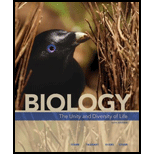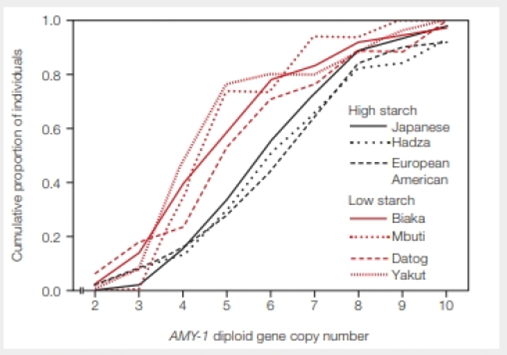
Concept explainers
Human Adaptation to a Starchy Diet The human AMY-1 gene encodes salivary amylase, an enzyme that breaks down starch. The number of copies of this gene varies, and people who have more copies generally make more enzyme. In addition, the average number of AMY-1 copies differs among cultural groups.
George Perry and his colleagues hypothesized that duplications of the AMY-1 gene would be selectively advantageous in cultures in which starch is a large part of the diet. To test this hypothesis, the scientists compared the number of copies of the AMY-1 gene among members of seven cultural groups that differed in their traditional diets. FIGURE 39.9 shows their results.

FIGURE 39.9 Number of copies of the AMY-1 gene among members of cultures with traditional high-starch or low-starch diets. The Hadza, Biaka, Mbuti, and Datog are tribes in Africa. The Yakut live in Siberia.
Starchy tubers are a mainstay of Hadza hunter–gatherers in Africa, whereas fishing sustains Siberia's Yakut. Almost 60 percent of Yakut had fewer than 5 copies of the AMY1 gene. What percentage of the Hadza had fewer than 5 copies?
To determine: The percentage of Hadza people who had fewer than five copies of AMY1 gene.
Introduction: An enzyme present in the saliva that initiates or mediates the hydrolysis of starch into simpler sugar molecules is called as salivary amylase. AMY-1 is the gene that encodes for the salivary amylase enzyme. Humans possess this gene, but copy number of that particular gene highly depends on their dietary habits. Varied number of the copy numbers of AMY1 genes is observed among the people. The people consuming high starchy diets have more copies of AMY1 gene when compared those with less starchy diets.
Explanation of Solution
Refer figure 39.9 “Number of copies of AMY-1 gene among members of cultures with high-starch or low-starch diets” in the textbook. It gives the information about cumulative proportion of individuals versus AMY-1 diploid gene copy number found in them. The variations in copy numbers of the salivary amylase (AMY-1) gene was tested among peoples of seven traditional groups that differ in their traditional food habits. They chose individuals with high starchy diet (Hadza, European American, and Japanese) and with low starchy diet (Yakut, Mbuti, Biaka, and Datog). Researchers observed a great difference in the enzyme copy number in the individuals of different populations.
Hadza are the hunter-gatherers (the people who follow hunting patterns for living instead of farming) in Africa. Their dietary habits include nuts, fruits, roots, berries, grasses, honey, seasonal vegetables, and also meat from animals. Because of high starch consumption, Hadza people possess high copy number of salivary enzyme, whereas, the Yakut tribes from Siberia mostly consume proteinaceous foods such as meat, fish, and milk. Therefore, most probably the salivary enzyme copy numbers will be lesser in the population of Yakut people.
From the given data shown in figure 39.9, almost 60% of Yakut had fewer than five copies of gene because they consume less starchy food. From the given graph, it can be materialized that approximately 30% of the Hadza population had fewer than 5 copies of the AMY-1 gene. The rest of the Hadza population about 70% of people had above 5 copies of AMY-1 gene. This is because of the high starch consumption habits followed among the Hadza population.
Want to see more full solutions like this?
Chapter 39 Solutions
Biology: The Unity and Diversity of Life (MindTap Course List)
Additional Science Textbook Solutions
Biological Science (6th Edition)
Microbiology Fundamentals: A Clinical Approach
Human Physiology: An Integrated Approach (8th Edition)
Genetics: From Genes to Genomes
Campbell Essential Biology (7th Edition)
- 22. Which of the following mutant proteins is expected to have a dominant negative effect when over- expressed in normal cells? a. mutant PI3-kinase that lacks the SH2 domain but retains the kinase function b. mutant Grb2 protein that cannot bind to RTK c. mutant RTK that lacks the extracellular domain d. mutant PDK that has the PH domain but lost the kinase function e. all of the abovearrow_forwardWhat is the label ?arrow_forwardCan you described the image? Can you explain the question as well their answer and how to get to an answer to an problem like this?arrow_forward
- Describe the principle of homeostasis.arrow_forwardExplain how the hormones of the glands listed below travel around the body to target organs and tissues : Pituitary gland Hypothalamus Thyroid Parathyroid Adrenal Pineal Pancreas(islets of langerhans) Gonads (testes and ovaries) Placentaarrow_forwardWhat are the functions of the hormones produced in the glands listed below: Pituitary gland Hypothalamus Thyroid Parathyroid Adrenal Pineal Pancreas(islets of langerhans) Gonads (testes and ovaries) Placentaarrow_forward
 Biology: The Dynamic Science (MindTap Course List)BiologyISBN:9781305389892Author:Peter J. Russell, Paul E. Hertz, Beverly McMillanPublisher:Cengage Learning
Biology: The Dynamic Science (MindTap Course List)BiologyISBN:9781305389892Author:Peter J. Russell, Paul E. Hertz, Beverly McMillanPublisher:Cengage Learning Biology: The Unity and Diversity of Life (MindTap...BiologyISBN:9781305073951Author:Cecie Starr, Ralph Taggart, Christine Evers, Lisa StarrPublisher:Cengage Learning
Biology: The Unity and Diversity of Life (MindTap...BiologyISBN:9781305073951Author:Cecie Starr, Ralph Taggart, Christine Evers, Lisa StarrPublisher:Cengage Learning Biology: The Unity and Diversity of Life (MindTap...BiologyISBN:9781337408332Author:Cecie Starr, Ralph Taggart, Christine Evers, Lisa StarrPublisher:Cengage Learning
Biology: The Unity and Diversity of Life (MindTap...BiologyISBN:9781337408332Author:Cecie Starr, Ralph Taggart, Christine Evers, Lisa StarrPublisher:Cengage Learning- Nutritional Sciences: From Fundamentals to Food, ...Health & NutritionISBN:9781337486415Author:McGuirePublisher:Cengage
 BiochemistryBiochemistryISBN:9781305577206Author:Reginald H. Garrett, Charles M. GrishamPublisher:Cengage Learning
BiochemistryBiochemistryISBN:9781305577206Author:Reginald H. Garrett, Charles M. GrishamPublisher:Cengage Learning Biology Today and Tomorrow without Physiology (Mi...BiologyISBN:9781305117396Author:Cecie Starr, Christine Evers, Lisa StarrPublisher:Cengage Learning
Biology Today and Tomorrow without Physiology (Mi...BiologyISBN:9781305117396Author:Cecie Starr, Christine Evers, Lisa StarrPublisher:Cengage Learning





